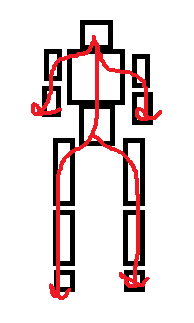This post will be a little long, but but please read and give your take on it anyways.
As the title suggests, I want to have a sort of discussion on the most efficient way to find the “limb flow” of a character body. What do I mean?

The character is just as it appears, a block man. The red lines represent the limb flow of the character. What I am trying to do is find which limbs are essentially children of a target limb. So in real use example, if you got shot in the left thigh and it fell off, the limb flow would suggest that also the left knee and left foot limbs would fall off too.
I am thinking of multiple ways to go about this, but this one I think initially would work best:
- A DFS style approach.
Properties:
Limbs have 3 properties:
Parent (name of parent, head parent == root)
Child (might be a little confusing, but this is just a bool saying if it has children, used to identify the leaf nodes)
Checked (if there is a node unchecked by our search, == false)
All limbs would be stored into a list initially.
When something is hit to die, first check if it was head, if it was instant death. Also check if it’s parent == Head, also instant death. If it is not, put that object name (the parent of the hit object) into variable parentObject
If not:
-Store the hit limb into a hitVariable, mark it as checked, and put it into the MFD list (explained further down)
-Iterate the list checking Child statuses, once you find one with status false and checked == false you know you found a leaf that has not been inspected yet. Now start checking parents. Move current item into a temp list Holder and mark property checked as True until one of two collisions:
- reached object where parent == head (made it all the way to the root with no collision)
- reached object where parent == hitVariable (NOTE* it would still execute this iteration of the loop, probs need to use a stopper variable, then change stopper variable status inside the loop)
if first choice, just move all items from Holder into a list Survivors (all limbs made it to the head without passing the hit)
if second choice, move all items from Holder into a list MFD (all limbs in list will fall off)
Once moved into Survivor or MFD, return to original list and clear Holder, start iterating again until a situation where Checked == false and Child == false, then repeat. Do this until all items in the list are marked checked.
Now, we have three lists. Original, Survivor, MFD. We simply run a loop iterating through MFD, ending objects on every iteration until the list is empty. Now we set our Original list = Survivor and clear Survivor as well.
A picture of a before/after execution to clarify end results:
NOTE: the variable in the picture MFD == Checked, I just made the picture before thinking the variable names out fully
Now we of course need to reset our leaf nodes, as we may have new leaf nodes. We also need to uncheck everything.
Using this setup, could now iterate through the new Original list, and look:
for i in list:
if i[‘parent’] == parentObject: (we now know we did not add any new leafs to our list, as the parentObject still has other children)
#do nothing really
else:
parentObject[‘Child’] = False (The else will trigger if this is now a leaf node)
i['checked'] = false
I think that should work for the purpose described. Any thoughts an opinions? Especially from the coders out there. This format obviously assumes there is not a crazy number of items in the list, and you will have to have no items with two or more parents, which shouldn’t be to hard just make complex shapes into one object if the situation ever came up.
